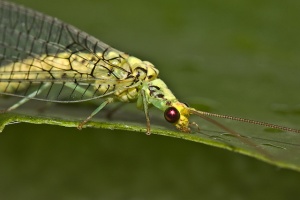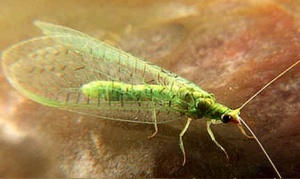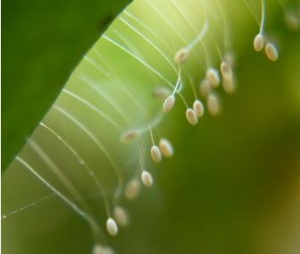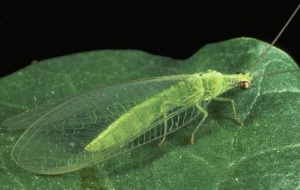Mallada sp.




Most lacewings (also) feed on plant material, such as pollen. Particularly green lacewings (Chrysopidae) such as Mallada boninensis, Mallada astur and Mallada signata are mainly predatory and very effective. They are relatively small (length up to 1.5 cm, including wings). Adults are active during the night, and may be attracted by flashlight. A female lacewing may plant over 100 eggs on plants infested with aphids. These eggs hang on a thin 1 cm long stalk, most often under a leaf. The eggs hatch within 4 days. The larval period lasts 12 days, and the pupal period lasts about 9 days. Adults live just one month. One may commercially rear millions of green lacewings for biological control of mango pests.
One may buy millions of lacewings (as captive-bred eggs) for biological pest control, as reared for that purpose in many countries. The larvae of most species of lacewings are specialised predators that eat aphids (and coccids such as mango scales, and caterpillars). These larvae sway their heads from left to right, and back, until they strike something they can eat. They have mouthparts that can pierce and suck the aphids. Many (adult) lacewing species also feed on nectar and pollen, but particularly Chrysopidae (eg Mallada signata, Mallada boninensis) are mainly predatory (one adult may eat 15 aphids per day). One may attract Chrysopidae by planting crops that attract them (mainly Asteraceae and Apiaceae), such as calliopsis (Coreopsis), cosmos (Cosmos), sunflowers (Helianthus), dandelion (Taraxacum), dill (Anethum) and angelica (Angelica).
Adult chrysopids have paired prothoracic glands that are thought to produce defensive secretions.[1]
Mallada boninensis
This green lacewing is an effective [2] generalist predator, feeding on mealy bugs (Mani and Krishnamoorthi, 1987), white flies (Selvakumaran et aI., 1996), bollworms and aphids (Kabissa et al., 1996) and on nymphs of Aphis gossypii, Aphis craccivora and Rhopalosiphum maidi [3], blackflies, psylla and leaf miner. Green lacewings are recommended for the integrated pest management programme (Nehare et al., 2004). M. boninensis feeds well on Corcyra cephalonica eggs[4] (laboratory host) C. cephalonica can be mass reared on Jowar along with groundnut, streptomycin, vitamin complex, Na and K salts.
Mallada signata
Adults are 15 mm long. Most pesticides are toxic to lacewings, and even fungicides may be disruptive. Mallada signata predates on a wide range of common pests, such as aphids, whitefly, mites, scales, small caterpillars and moth eggs. M. signata is native to Australia. Lacewings (both larvae and adults) are most effective against aphids. Females will start laying eggs 1 week after emergence, and may lay up to 600 eggs. Eggs are laid on fine stalks. Newly hatched larvae immediately start eating aphids and may grow up to 8 mm in 12 days. Larvae are pinchers for attacking prey. They carry debris on their backs. The larvae may eat hundreds of aphids in those 12 days until pupation. Adults emerge after 9 days.
Rearing lacewings, one needs to provide them with food continuously, to prevent canabalism. Mass-reared Mallada signata are commercially available. They are supplied as eggs from which larvae will hatch within days. Distribution in the field: Initially 5 eggs per square meter, followed by releases of 1 egg per square meter.
M. signata produces two distinct classes of silk. The final instar larvae spin protein fibers to construct a loosely woven cocoon. In a second stage of cocoon construction, the insects lay down an inner wall of lipids that uses the fibers as a scaffold. These larval cocoon silk and egg-stalk silk are not related. The silk protein fibers may provide the mechanical strength of the composite lacewing cocoon whereas the lipid layer may provide a barrier to water loss during pupation.[5]
Specific hybrids of wild and cultivated tomato plants (meant to reduce pesticide use) negatively effects Mallada signata (increasing mortality).[6]
Mallada desjardinsi
M. desjardinsi development from eggs to adults takes 32 days on average. The development of eggs, larvae and pupae takes 5 days, 14 days and 13 days respectively. After a mean pre oviposition period of 7 days, one female averagely lays 253 eggs during her life time. Male adult longevity is 40 days. Female adult longevity is 58 days.
Green lacewings predate on various small bugs, including aphids. Various ant species farm and protect aphids against their natural enemies, including green lacewings. Larvae of Mallada desjardinsi, prey on cowpea aphids, but are not attacked by farming ants because these M. desjardinsi larvae carry aphid carcasses on their backs. The cuticular hydrocarbons in these carcasses function as a chemical camouflage to limit attacks by aphid-tending ants.[7]
M. desjardinsi also predates on the Red spider mite, a tea pest. The optimum predator-prey ratios are 1:50 and 1:33 under laboratory conditions and the ratios were 1:33 and 1:25 in green house conditions.[8]
